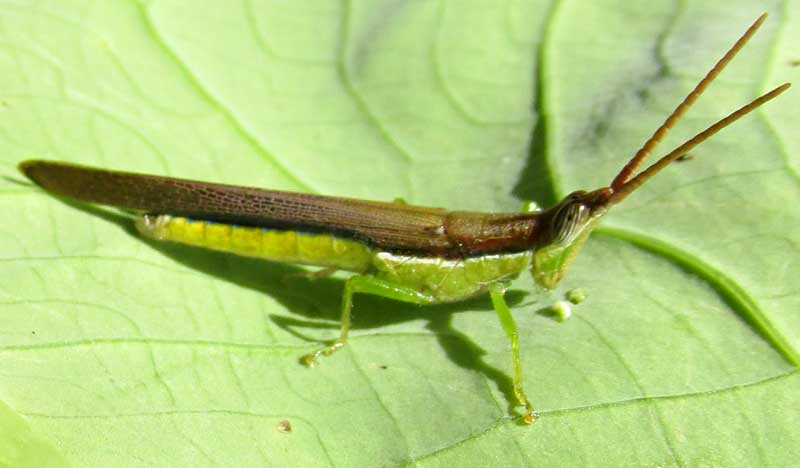Excerpts from Jim Conrad's
Naturalist Newsletter
from the May 29, 2016 Newsletter issued from Hacienda Chichen Resort beside Chichén Itzá Ruins; limestone bedrock; elevation ~39m (~128ft), N20.675°, W88.569°; central Yucatán state, MÉXICO
CATTAIL TOOTHPICK GRASSHOPPER
Hanging on the underside of a big Arrowleaf Elephant-ear leaf right outside the hut's door, there was a greenish, grasshoppery-looking critter unlike any grasshopper I'd seen before, shown below:

Unfortunately it hopped away the moment that picture was taken, but still in that photo we can see the interesting pointy head. The antennae are thicker and stiffer looking than other grasshopper antennae I've seen, and appear to be somewhat flattened toward their bases.
Naturally the picture was shipped off to volunteer identifier Bea in Ontario, who quickly shot back that she thought it must be close to the genus Leptysma, known as the Spur-throat Toothpick Grasshoppers. When I checked which Leptysma species might occur in the Yucatan, a picture of LEPTYSMA MARGINICOLLIS popped up, looking exactly like our elephant-ear-leaf one. Bea was hesitant about the ID because most of the pictures she found of the species showed brown individuals. However, a US Forest Service page says that males are reddish brown while females are green.
In the US the species is known as the Cattail Toothpick Grasshopper, the cattail part of the name arising from the fact that often in the US Deep South it turns up among cattails and sedges at the water's edge. I water the elephant-ears daily, so they're the closest thing to a cattail thicket we have here. Probably the toothpick part of the grasshopper's name refers to a short spur, or spine, between the front legs, not visible in our picture.
Cattail Toothpick Grasshoppers occur from the southern US throughout Mexico to Honduras in Central America, and have been divided into three subspecies. They belong to the Short-horned Grasshopper Family, the Acrididae.